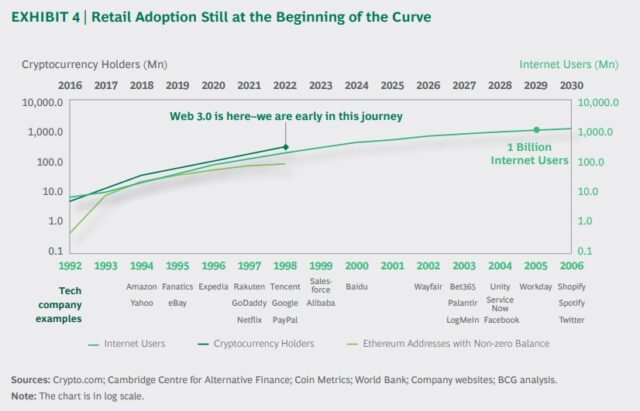In a report titled “What Does The Future Hold For Crypto Exchanges?”, the digital asset class is stated to be in its early days. The report was published by Boston Consulting Group, Bitget, and Foresight Ventures to highlight and measure the progress achieved by this nascent industry in the past few years.
Related Reading | Crypto Reacts: Tesla Panic Sells Its Bitcoin, The Internet Explodes
The report emphasized the growth of digital assets in the long term despite the recent downside price action. When compared to 2017, when Bitcoin, Ethereum, and other large cryptocurrencies reached their previous all-time highs, the industry has seen a massive expansion in 5 years alone.
In 2017, there were only 800 crypto-based applications. These have expanded over 10-fold at registered 10,000 today backed by a surge in institutional capital which stands at 68% of the total trading volume in the crypto market compared to 2020 recorded in 2018. The report stated:
(…) crypto prices drive interest, which drives ideas and activity, which in turn drive innovation. The 2017 ICO (Initial Coin Offering) boom led to the emergence of crypto exchange that are leading the market today.
In terms of adoption, the crypto industry is still early, the report claims. Only 0.3% of individual wealth has been injected into digital assets in contrast with 25% of individual wealth invested in traditional assets, such as equities. The report stated:
Relatively shallow penetration indicates that there is headroom for growth (…). North America is the most invest geography, with an average holding of around $18,000 among crypto holders, accounting for 0.4% of total individual wealth (…).
As seen below, the report concluded that crypto holders are projected to grow up to 1 billion by 2030 if the nascent asset class follows a similar trajectory to that of the internet. In these terms, digital asset adoption stands at something like the internet in 1998.
Institutions Adopt Crypto, But Unevenly
As mentioned, the report claims there has been an uptick in institutional interest in cryptocurrencies. However, hedge funds and venture capital firms have been the keenest to enter the space when compared to Pension Funds, banks, and corporations.
While hedge funds and venture capital firms recorded almost $70 billion in crypto assets under management (AUM) by 2021, banks and companies recorded $2.5 billion, government funds $4 billion, and pension funds $1 billion.
The trend hints at the upside with potential for these investments to even out over the long run. The report added:
We expect allocations to continue to rise. There is also an expanding class of crypto-native funds (e.g., Paradigm, Hashed) that are picking up momentum. Traditional private equity funds are algo getting bullish on crypto.

Related Reading | Mercado Bitcoin, A Brazilian Crypto Exchange, To Expand Into Mexico
Tony Cheng, General Partner at Foresight Ventures and Head of Corporate Development at Bitget stated the following on the nascent industry and its potential to continue to operate as a disruptor element across multiple sectors:
The crypto market has seen significant progress over the past few years. We have seen the market mature significantly as global user penetration grows with new use cases being built out for Web3 and institutional flows increasing allocation to this new asset class.


